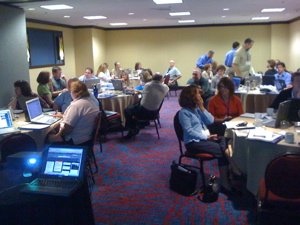The last topics in our 2 day game design workshop for the Guild (great group of attendees, great experience) were evaluation, production, and organizational issues. On the production issue, the perennial topic of tools came up. In thinking about it, I realized that we needed a map, so I started coming up with one (a diagram, of course :) ). I ran it past Jeff (Johannigman, my co-conspirator on the workshop) in our taxi to the airport, to his general approval.
The two dimensions are complexity of the scenario (only covering branching and model-driven), and the power (e.g. complexity) of the tool. It’s a pretty linear map, and realize that small distances aren’t significant (so the clusters are roughly equivalent).
The impossible dream is that tool that everyone wants that makes it easy to develop model-driven interactions. Sorry, I’m convinced it can’t exist, because to be flexible enough to cover all the different models that we’d want to represent, it’s got to be so general as to be essentially just a programming language. QED (Quinn Ephemeral Decision).
This is a first stab, so feedback welcome. If desired, I can create it in Gliffy and we can collaboratively develop it (though my first effort with that was underwhelming in participation…). Thoughts?


